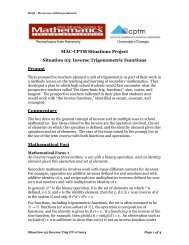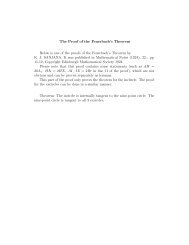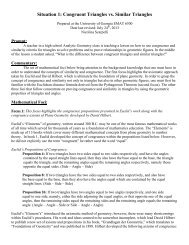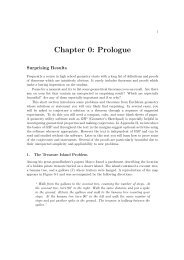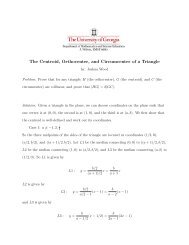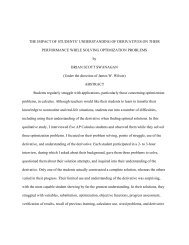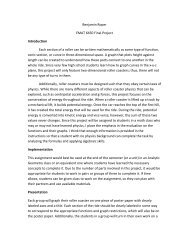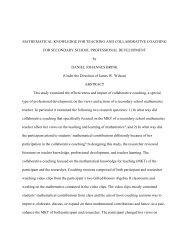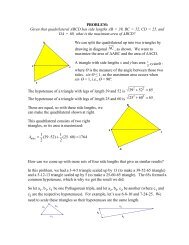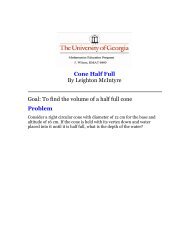Irrational Lengths Sydney Roberts Prepared at University of Georgia ...
Irrational Lengths Sydney Roberts Prepared at University of Georgia ...
Irrational Lengths Sydney Roberts Prepared at University of Georgia ...
You also want an ePaper? Increase the reach of your titles
YUMPU automatically turns print PDFs into web optimized ePapers that Google loves.
Situ<strong>at</strong>ion: <strong>Irr<strong>at</strong>ional</strong> <strong>Lengths</strong><strong>Sydney</strong> <strong>Roberts</strong><strong>Prepared</strong> <strong>at</strong> <strong>University</strong> <strong>of</strong> <strong>Georgia</strong>Last Revised: July 17, 2013PromptA secondary pre-service teacher was given the following task to do during an interview:Given: square ABCD.Construct a square whose area is half the area <strong>of</strong> square ABCD.(Note: The pre-service teacher was not given a drawing or anydimensions for ABCD.)The student chose the dimensions <strong>of</strong> ABCD to be 1 unit by 1 unit and approached the problem in twoways.Method 1: Reasoning with a figureShe divided ABCD into smaller squares as shown in Figure 1a and noted each small square has area .Sketching a new square as in Figure 1b, she claimed a square has area . She concluded th<strong>at</strong> thesquare she wants (sketched in Figure 1c) has a side length somewhere between one-half and threefourths.Method 2: Reasoning from a formulaAssuming implicitly th<strong>at</strong> the area <strong>of</strong> given square ABCD is 1 square unit, she noted th<strong>at</strong> the desired area<strong>of</strong> the new square is one-half square unit. Using a formula for the area <strong>of</strong> a square, she produced
Focus 2The value <strong>of</strong>can be approxim<strong>at</strong>ed using several methods. A simple hand calcul<strong>at</strong>or would present agood estim<strong>at</strong>ion, as well as using different algorithms and Newton’s method.Using a calcul<strong>at</strong>or, one could punch inand obtain a numerical approxim<strong>at</strong>ion <strong>of</strong> 0.7071. However, thisdecimal doesn’t termin<strong>at</strong>e (a property <strong>of</strong> irr<strong>at</strong>ional numbers) and hence measuring this length would stillprove to be r<strong>at</strong>her difficult.Another method to finding an estim<strong>at</strong>e is using the “Divide-and-Average” method which is also knownas the Babylonian Algorithm which d<strong>at</strong>es back to 1700 B.C. This method involves starting with a guess <strong>of</strong>the square root <strong>of</strong> an integer, call it x, and then average the guess with the quotient <strong>of</strong> x and the guess.Take this new value and average it with the quotient <strong>of</strong> x and this value. This process can be repe<strong>at</strong>ed tocontinue getting a more accur<strong>at</strong>e approxim<strong>at</strong>ion. For example, consider finding an estim<strong>at</strong>e forSince the square root <strong>of</strong> 1 is 1, and the square root <strong>of</strong> 4 is 2, then the square root <strong>of</strong> two must liesomewhere between one and two. Let the guess be 1.5.Using a calcul<strong>at</strong>or, the square root <strong>of</strong> two is approxim<strong>at</strong>ely 1.4142, so this method provides a veryaccur<strong>at</strong>e estim<strong>at</strong>e. One could then use the division algorithm to findexplan<strong>at</strong>ion <strong>of</strong> why this algorithm works, refer tohttp://www.m<strong>at</strong>hp<strong>at</strong>h.org/Algor/squareroot/algor.babylon.htm.. For anAnother method for finding square roots is the square-root algorithm which is much like the longdivision process. However, this process is long and tedious, and overall not as intuitive as theBabylonian Algorithm. For reference though, the following website provides a gre<strong>at</strong> outline <strong>of</strong> theprocess. http://www.homeschoolm<strong>at</strong>h.net/teaching/sqr-algorithm-why-works.phpOne could also use Newton’s Method to approxim<strong>at</strong>e square root values. Essentially, Newton’s Methodfinds approxim<strong>at</strong>es to the roots <strong>of</strong> a function. Newton’s method is defined as a sequence th<strong>at</strong> gener<strong>at</strong>essuccessively better approxim<strong>at</strong>ions for the roots <strong>of</strong> the function. The algorithm for Newton’s Method isas follows
AndTo approxim<strong>at</strong>e , use the function th<strong>at</strong> is presented in the prompt: . To define this as afunction where the root would be , the function could be . Then using as theinitial guess like before, the algorithm yieldsRepe<strong>at</strong>ing this algorithm will yield increasingly more accur<strong>at</strong>e approxim<strong>at</strong>ions, but <strong>at</strong> this point thesuccessive approxim<strong>at</strong>ions are remaining the same up to five decimal places, so it is safe to say th<strong>at</strong>.Focus 3The Pythagoreans discovered th<strong>at</strong> some irr<strong>at</strong>ional lengths can be constructed by using a compass andstraightedge. More specifically, the square root <strong>of</strong> positive integers can be constructed, whether or notthe value is r<strong>at</strong>ional or irr<strong>at</strong>ional.When discussing geometric constructions, it is important to be aware <strong>of</strong> Euclid’s construction axioms.Euclid assumed th<strong>at</strong> it is possible to:1. Draw a straight line segment between any two points2. Extend a straight line segment indefinitely3. Draw a circle with given center and radius.
Using these axioms, one could construct perpendicular segments by finding the intersection points <strong>of</strong>two circles with equal radii as shown below where A and B are the centers <strong>of</strong> the two circlesrespectively. Then the line segment would be perpendicular to .Using this, one could construct a square given a line segment with one unit length. Start by constructingtwo perpendicular lines, so th<strong>at</strong> a 90° angle is present.Then construct a line segment where one endpoint is <strong>at</strong> the constructed 90° angle. This segment willbe the side length <strong>of</strong> the square, so one could set the compass to any radius and preserve this length(let’s call it one unit).
Now, preserving the length <strong>of</strong> segment , copy th<strong>at</strong> length along the perpendicular to .Now sense the length was preserved, . Now keeping the compass set to the length <strong>of</strong> .Construct to circles <strong>of</strong> radius around point A and point C. Where these two circles intersect will bethe fourth corner <strong>of</strong> the square.
Now, construct a point <strong>at</strong> the intersection <strong>of</strong> the new circles, and construct straight line segments topoints A and C. Then the square ABCD has been constructed.Now using the straight edge, the diagonal <strong>of</strong> the square could be drawn, which is known to have alength <strong>of</strong> The result <strong>of</strong> this shows th<strong>at</strong> this irr<strong>at</strong>ional length can, in fact, be constructed even if itcan’t be measured.Furthermore, there is a way to construct the square roots <strong>of</strong> integers by repe<strong>at</strong>edly constructing righttriangles. Starting with a line segment <strong>of</strong> length , then rot<strong>at</strong>ing this length by 90° to form a righttriangle, an isosceles right triangle with base lengths <strong>of</strong> 1 and hypotenuse <strong>of</strong> has been constructed.Then construct another leg <strong>of</strong> a right triangle with length <strong>of</strong> 1 <strong>at</strong>tached to the segment, the
hypotenuse <strong>of</strong> this triangle would beas the picture below shows.This construction can continue on and a spiral will start to formFocus 4Given square ABCD th<strong>at</strong> is divided into 4 smaller congruent squares, a diagonal <strong>of</strong> the smaller squarescan be formed and has a length <strong>of</strong> .In Method 1, the pre-service teacher thought to take the 1x1 square ABCD and divide it into foursmaller, congruent squares. As noted in the figure below. It was noted in the prompt th<strong>at</strong> these smallersquares have an area <strong>of</strong> ¼ th<strong>at</strong> <strong>of</strong> the original square.The goal is to find a square th<strong>at</strong> has the area <strong>of</strong> ½. Consider the triangle constructed by taking thediagonal <strong>of</strong> the square.Note th<strong>at</strong> by using the area <strong>of</strong> a triangle formula <strong>of</strong>th<strong>at</strong> the area <strong>of</strong> thissmaller triangle is ½ <strong>of</strong> the area <strong>of</strong> the smaller square. Now it would follow th<strong>at</strong> by dividing each <strong>of</strong> thesmaller squares in half by a triangle, we would have 4 figures th<strong>at</strong> look as follows.
Is this new figure a square? Yes. Because the triangles were formed by cutting the smaller square in halfand bisecting a corner <strong>of</strong> the square, the triangle is a 45°- 45°- 90° triangle with base lengths ½. Then thecorner <strong>of</strong> the quadril<strong>at</strong>eral figure formed must be 45°+45°=90°. To find the side length <strong>of</strong> this figure, thePythagorean Theorem can be used to see th<strong>at</strong> the squared sums <strong>of</strong> the base legs areso the side lengths <strong>of</strong> the figure formed would be <strong>of</strong> equal length. Then thearea <strong>of</strong> this square isfact between ½ and ¾.as desired with a side length <strong>of</strong> approxim<strong>at</strong>ely 0.7071 which is inReferences:http://www.m<strong>at</strong>hp<strong>at</strong>h.org/Algor/squareroot/algor.square.root.htmhttps://en.wikipedia.org/wiki/<strong>Irr<strong>at</strong>ional</strong>_number#Ancient_Greecehttp://www.illustr<strong>at</strong>ivem<strong>at</strong>hem<strong>at</strong>ics.org/illustr<strong>at</strong>ions/966Stillwell, John. The Four Pillars <strong>of</strong> Geometry. New York: Springer, 2005. Print.



